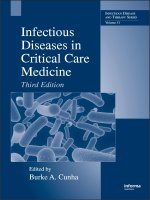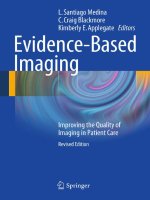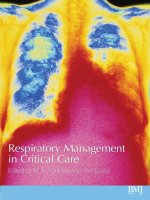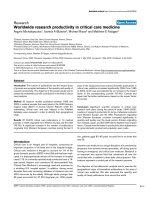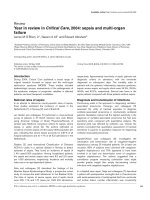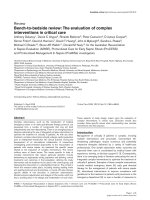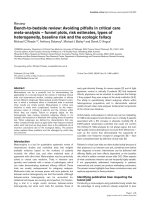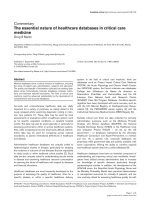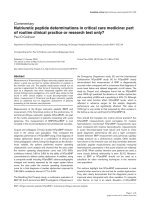17 the brigham board review in critical care medicine 2017
Bạn đang xem bản rút gọn của tài liệu. Xem và tải ngay bản đầy đủ của tài liệu tại đây (36.97 MB, 1,355 trang )
251
CMEinfo presents a
definitive multimedia course
THE BRIGHAM BOARD REVIEW IN
CRITICAL CARE MEDICINE
from
The Brigham Board Review in Critical Care Medicine
Presented by: Brigham and Women’s Hospital
Provided by: Oakstone Publishing, LLC
________________________________________________
DATE OF ORIGINAL RELEASE: May 31, 2017
DATE CREDITS EXPIRE: May 31, 2020
TARGET AUDIENCE:
The primary group of learners will be fellows/trainees and practicing critical care specialists
(MDs), NP’s, and other professional affiliates (internists with an interest in critical care) who are
preparing to take ABIM Board Review or Recertification Examinations or who seek CME
activities to improve patient care in the area of critical care medicine. Currently, the target
audience is regional, national & international.
ESTIMATED TIME TO COMPLETE:
It is estimated that it should take the average learner 30.5 hours to complete the activity.
ACCREDITATION:
Oakstone Publishing, LLC is accredited by the Accreditation Council for Continuing Medical
Education (ACCME) to provide continuing medical education for physicians.
Oakstone Publishing, LLC is accredited as a provider of continuing nursing education by the
American Nurses Credentialing Center's Commission on Accreditation.
DESIGNATION:
Oakstone Publishing, LLC designates this enduring material for a maximum of 30.5 AMA PRA
Category 1 Credits™. Physicians should claim only the credit commensurate with the extent of
their participation in the activity.
Contact hours: 30.5
Successful completion of this CME activity, which includes participation in the evaluation
component, enables the participant to earn up to 30.5 MOC points in the American Board of
Internal Medicine’s (ABIM) Maintenance of Certification (MOC) program. Participants will
earn MOC points equivalent to the amount of CME credits claimed for the activity. It is the CME
activity provider’s responsibility to submit participant completion information to ACCME for
the purpose of granting ABIM MOC credit.
SPECIAL PREREQUISITES FOR PARTICIPANTS: There are no prerequisites for
participants.
METHOD OF PARTICIPATION: Review Video/Audio program, complete the
comprehensive activity evaluation and score 70% or greater on the required posttest to assess the
knowledge gained from reviewing the program.
251
LEARNING OBJECTIVES:
At the conclusion of this activity, the participant will be able to:
•
•
•
•
•
•
Apply current/recommended critical care guidelines in clinical practice;
Perform differential diagnosis of complex clinical presentations related to critical care
disorders;
Identify and Apply current therapeutic options for specific critical care disorders;
Analyze and Interpret up-to-date literature relevant to clinical practice in critical care
medicine;
Recognize and Apply knowledge of pathophysiology as it applies to management of
critical care disorders;
Apply knowledge gained to the ABIM certification/recertification critical care
examinations
FACULTY AFFILIATIONS DISCLOSURE:
Oakstone Publishing, LLC has assessed conflict of interest with its faculty, authors, editors, and
any individuals who were in a position to control the content of this CME activity. Any
identified relevant conflicts of interest were resolved for fair balance and scientific objectivity of
studies utilized in this activity. Oakstone Publishing’s planners, content reviewers, and editorial
staff disclose no relevant commercial interests.
Disclosure information for individuals in control of the content of the activity can be found
at the beginning of each lecture.
WARNING:
The copyright proprietor has licensed the picture contained on this recording for private
home use only and prohibits any other use, copying, reproduction, or performance in
public, in whole or in part (Title 17 USC Section 501 506).
CMEinfo is not responsible in any way for the accuracy, medical or legal content of this
recording. You should be aware that substantive developments in the medical field covered
by this recording may have occurred since the date of original release.
© 2017 Ebix, Inc. DBA Oakstone Publishing. LLC.
CMEinfo is a registered trademark of Oakstone Publishing, LLC.
251
The Brigham Board Review in Critical Care Medicine
Faculty List
________________________________________________
Course Director
Gerald L. Weinhouse, MD
Assistant Professor of Medicine
Harvard Medical School
Division of Pulmonary and Critical Care Medicine
Department of Medicine
Brigham and Women’s Hospital
Faculty
Rebecca M. Baron, MD
Assistant Professor of Medicine
Harvard Medical School
Division of Pulmonary and Critical Care
Medicine
Department of Medicine
Brigham and Women’s Hospital
Phillip C. Camp, Jr., MD
Instructor in Surgery
Harvard Medical School
Division of Thoracic Surgery
Department of Surgery
Brigham and Women’s Hospital
Bartolome R. Celli, MD
Professor of Medicine
Harvard Medical School
Division of Pulmonary and Critical Care
Medicine
Department of Medicine
Brigham and Women’s Hospital
Kenneth B. Christopher, MD
Assistant Professor of Medicine
Harvard Medical School
Renal Division
Department of Medicine
Brigham and Women’s Hospital
Jean M. Connors, MD
Assistant Professor of Medicine
Harvard Medical School
Division of Hematology
Department of Medicine
Brigham and Women’s Hospital
Akshay Desai, MD, MPH
Associate Professor of Medicine
Harvard Medical School
Division of Cardiovascular Medicine
Department of Medicine
Brigham and Women’s Hospital
Katherine E. Economy, MD
Assistant Professor of Obstetrics,
Gynecology and Reproductive Biology
Harvard Medical School
Department of Obstetrics and Gynecology
Brigham and Women’s Hospital
James F. Gilmore, PharmD
Clinical Pharmacy Specialist
Department of Pharmacy Services
Brigham and Women’s Hospital
Hilary Goldberg, MD
Assistant Professor of Medicine
Harvard Medical School
Division of Pulmonary and Critical Care
Medicine
Department of Medicine
Brigham and Women’s Hospital
Edward Kelly, MD
Assistant Professor of Surgery
Harvard Medical School
Division of Trauma, Burn, and Surgical
Critical Care
Department of Surgery
Brigham and Women’s Hospital
Samuel Goldhaber, MD
Professor of Medicine
Harvard Medical School
Division of Cardiovascular Medicine
Department of Medicine
Brigham and Women’s Hospital
Michael Klompas, MD
Associate Professor of Population Medicine
Harvard Medical School
Division of Infectious Diseases
Department of Medicine
Brigham and Women’s Hospital
Kathleen Haley, MD
Assistant Professor of Medicine
Harvard Medical School
Division of Pulmonary and Critical Care
Medicine
Department of Medicine
Brigham and Women’s Hospital
Daniela Lamas, MD
Instructor in Medicine
Harvard Medical School
Division of Pulmonary and Critical Care
Medicine
Department of Medicine
Brigham and Women’s Hospital
Galen Henderson, MD
Assistant Professor of Neurology
Harvard Medical School
Department of Neurology
Brigham and Women’s Hospital
Linda Lee, MD
Assistant Professor of Medicine
Harvard Medical School
Division of Gastroenterology, Hepatology
and Endoscopy
Department of Medicine
Brigham and Women’s Hospital
Margo Hudson, MD
Assistant Professor of Medicine
Harvard Medical School
Division of Endocrinology, Diabetes and
Hypertension
Department of Medicine
Brigham and Women’s Hospital
Jennifer Johnson, MD
Instructor in Medicine
Harvard Medical School
Division of Infectious Diseases
Department of Medicine
Brigham and Women’s Hospital
Anthony F. Massaro, MD
Instructor in Medicine
Harvard Medical School
Division of Pulmonary and Critical Care
Medicine
Department of Medicine
Brigham and Women’s Hospital
Melanie Maytin, MD
Instructor in Medicine
Harvard Medical School
Division of Cardiovascular Medicine
Department of Medicine
Brigham and Women’s Hospital
Julia McNabb-Baltar, MD, MPH
Instructor in Medicine
Harvard Medical School
Division of Gastroenterology, Hepatology
and Endoscopy
Department of Medicine
Brigham and Women’s Hospital
Paul F Nuccio, MS, RRT, FAARC
Director of Pulmonary Services
Division of Pulmonary and Critical Care
Medicine
Department of Medicine
Brigham and Women’s Hospital
Dana-Farber Cancer Institute
James Rawn, MD
Instructor in Surgery
Harvard Medical School
Division of Cardiac Surgery
Department of Surgery
Brigham and Women’s Hospital
Chanu Rhee, MD
Instructor in Population Medicine
Harvard Medical School
Division of Infectious Diseases
Department of Medicine
Brigham and Women’s Hospital
Malcolm K. Robinson, MD
Assistant Professor of Surgery
Harvard Medical School
Division of General Surgery
Department of Surgery
Brigham and Women’s Hospital
Anna Rutherford MD, MPH
Assistant Professor of Medicine
Harvard Medical School
Division of Gastroenterology, Hepatology
and Endoscopy
Department of Medicine
Brigham and Women’s Hospital
Raghu R. Seethala, MD
Instructor in Emergency Medicine
Harvard Medical School
Department of Emergency Medicine
Brigham and Women’s Hospital
Benjamin M. Scirica, MD, MPH, FACC
Associate Professor of Medicine
Harvard Medical School
Division of Cardiovascular Medicine
Department of Medicine
Brigham and Women’s Hospital
Simon Talbot, MD
Assistant Professor of Surgery
Harvard Medical School
Division of Plastic Surgery
Department of Surgery
Brigham and Women’s Hospital
Taylor Thompson, MD
Professor of Medicine
Harvard Medical School
Division of Pulmonary and Critical Care
Medicine
Department of Medicine
Massachusetts General Hospital
J. Kevin Tucker, MD
Assistant Professor of Medicine
Harvard Medical School
Renal Division
Department of Medicine
Brigham and Women’s Hospital
Aaron Waxman, MD, PhD
Associate Professor of Medicine
Harvard Medical School
Division of Pulmonary and Critical Care
Medicine
Department of Medicine
Brigham and Women’s Hospital
Presented by: Brigham and Women’s Hospital
Provided by: Oakstone Publishing, LLC
The Brigham Board Review in Critical Care Medicine
May 31, 2017
Topic/Speaker
Book
Page #
SHOCK
Septic Shock - Princples and Practices of Resuscitation
Rebecca M. Baron, MD
Sepsis: New Definitions and Guidlines
Chanu Rhee, MD
Hemodynamic Monitoring
Aaron Waxman, MD, PhD
Hemorrhagic Shock
Edward Kelly, MD
Approach to Diagnosis and Management of Cardiogenic Shock
Akshay Desai, MD, MPH
1
25
62
86
106
RESPIRATORY FAILURE
ARDS-New Definition and Treatment
Taylor Thompson, MD
ARDS – Mechanical Ventilation
Taylor Thompson, MD
Management of Severe Obstructive Lung Disease
Bartolome R. Celli, MD
Invasive and non-Invasive Mechanical Ventilation:
Basic Principles and Goals
Paul F Nuccio, MS, RRT, FAARC
Mechanical Ventilation:Liberation and ABCDEF Bundle
Anthony F. Massaro, MD
143
169
196
237
258
CARDIAC ISSUES IN THE ICU
Acute Coronary Syndromes
Benjamin M. Scirica, MD, MPH, FACC
Arrhythmias
Melanie Maytin, MD
Indications and management of implantable electronic cardiac
devices in ICU patients
Melanie Maytin, MD
Post-Cardiac Arrest Care
Benjamin M. Scirica, MD, MPH, FACC
Pulmonary Embolism in the ICU
Samuel Goldhaber, MD
286
312
343
403
429
GI ISSUES IN THE ICU
Pancreatitis
Julia McNabb-Baltar, MD
445
Presented by: Brigham and Women’s Hospital
Provided by: Oakstone Publishing, LLC
The Brigham Board Review in Critical Care Medicine
May 31, 2017
Topic/Speaker
Book
Page #
GI ISSUES IN THE ICU
GI Bleed
Linda Lee, MD
Acute Liver Failure
Anna Rutherford, MD, MPH
463
494
NEURO ISSUES IN THE ICU
Advances in Stroke
Galen V. Henderson, MD
Intracranial Hypertension
Galen V. Henderson, MD
Seizures and Status Epilepticus
Galen V. Henderson, MD
Approach to the Comatose Patient
Galen V. Henderson, MD
521
576
619
647
HEMATOLOGIC ISSUES IN THE ICU
Transfusion Practices in the ICU
James Rawn, MD
Coagulopathies and Thrombocytopenia
Jean M. Connors, MD
685
726
RENAL ISSUES IN THE ICU
Acute Kidney Injury and Renal Replacement Therapy
Kenneth B. Christopher, MD
Acid-base Disorders; ABG’s
Kenneth B. Christopher, MD
748
777
INFECTIOUS DISEASE ISSUES IN THE ICU
Ventilator-Associated Pneumonia:
Diagnosis, Therapy, Prevention
Michael Klompas, MD
Infection, FUO, and Antibiotic Use in the ICU
Jennifer A. Johnson, MD
802
845
ENDOCRINE ISSUES IN THE ICU
Hyperglycemia and Glycemic Control in the ICU
Margo Hudson, MD
Endocrine Crises in the ICU
Margo S. Hudson, MD
868
905
Presented by: Brigham and Women’s Hospital
Provided by: Oakstone Publishing, LLC
The Brigham Board Review in Critical Care Medicine
May 31, 2017
Topic/Speaker
Book
Page #
GENERAL CARE ISSUES IN THE ICU
Fundamentals of Clinical Nutrition: Essentials for the Critical Care Specialist
Malcolm K. Robinson, MD
Prophylaxis in the ICU
Kathleen Haley, MD
939
976
SURGICAL CRITICAL CARE ISSUES IN THE ICU
Treatment of the Patient with Burns and Inhalational Injuries
Simon G. Talbot, MD
Abdominal Catastrophes and Abdominal Compartment Syndrome
Edward Kelly, MD
Obstetrical Critical Care
Katherine E. Economy, MD
998
1030
1051
MISCELLANEOUS ICU ISSUES
Ethical Dilemmas in the ICU
Kathleen Haley, MD
Critical Care Pharmacology
James F. Gilmore , PharmD
Toxic Ingestions
J. Kevin Tucker, MD
Sedation and Delirium in the ICU
Gerald L. Weinhouse, MD
ICU Issues for the Transplant Patient
Hilary Goldberg, MD
Mechanical Support Devices in ICU
Phillip C. Camp, Jr., MD
Ultrasound in the ICU: What Every Intensivist Should Know
Raghu R. Seethala, MD
Post Intensive Care Syndrome
Daniela Lamas, MD
1098
1118
1147
1187
1208
1234
1273
1315
Copyright © Oakstone Publishing, LLC, 2017. All Rights Reserved.
“Septic Shock:
Principles and Practices
of Resuscitation”
Rebecca M. Baron, M.D.
Pulmonary/Critical Care Medicine
Associate Physician, Brigham and Women’s Hospital
Assistant Professor of Medicine, Harvard Medical School
2017
Disclosures: None
2
1
Copyright © Oakstone Publishing, LLC, 2017. All Rights Reserved.
•
SEPSIS: (>10% mortality)
• Life-threatening organ dysfunction
• Caused by dysregulated response to infection
• Increase SOFA score of ≥2
• SHOCK: (>40% mortality)
• Vasopressors for MAP≥65 mmg Hg
• Lactate>2 mmol/L
• In absence of hypovolemia
•
qSOFA
• Out of hospital, ED, Ward settings
• Worse outcomes predicted from sepsis with 2 of:
• Respiratory Rate ≥ 22/min
• Altered mental status (GCS ≤ 13)
• SBP ≤ 100 mmHg
• Requires real-world validation prior to use
2
Copyright © Oakstone Publishing, LLC, 2017. All Rights Reserved.
What about fluid resuscitation?
*Treatment began in E.D.: 6-hours
*A-line, Central line insertion
*Monitored: Mean arterial BP (MAP)
Central venous pressure (CVP)
Central venous O2 sat (SCVO2)
Hematocrit
5
NEJM 2001; 345:1368
Oxygen Supply vs. Demand
Rivers, E. P. et al. CMAJ 2005;173:1054-1065
3
6
Copyright © Oakstone Publishing, LLC, 2017. All Rights Reserved.
EARLY Goal-Directed Therapy
INTERVENTION
500cc IVF Q 30 min!
NL arterial pH
NL base deficit
NL lactate
ScvO2 > 70%
Norepinephrine
Dobutamine: dose
increased 2.5 mcg Q
15 min!
MAP-RAP=C.O. X SVR
7
EARLY Goal-Directed Therapy
GOALS ACHIEVED???
0 Hr
6 Hr
8
4
Copyright © Oakstone Publishing, LLC, 2017. All Rights Reserved.
EARLY Goal-Directed Therapy
HOW’D THEY DO THAT??
9
EARLY Goal-Directed Therapy
IT WORKED!!
10
5
Copyright © Oakstone Publishing, LLC, 2017. All Rights Reserved.
Pro
EGDT
Con
1341 Patients, Compared:
1. EGDT, vs.
2. Protocolized care without CVC, inotropes,
blood, vs.
3. Usual care
NO DIFFERENCE in Primary outcome of
60d in-hospital mortality or other outcomes
12
6
Copyright © Oakstone Publishing, LLC, 2017. All Rights Reserved.
ProCESS*: What does it mean?
Mortality in usual care group substantially
lower than in EGDT in first trial (18% vs.
46%), thus “usual care” has evolved.
Severe sepsis without septic shock wasn’t
studied in ProCESS.
Two Other large trials similar results
This trial and general practice supports
early antibiotics and fluids and uncertain re:
CVC for everyone, PRBCs**, dobutamine.
Surviving Sepsis Bundle Changes 2016.
*and ARISE and PROMISE trials,
NEJM 2014 and 2015
**TRISS trial, NEJM 2014: restrictive strategy
13
BWH Trends in “Usual Care”
Fig. 1: Time to Antibiotic Administration
6:00
From ED Arrival
Hours:Minutes
From Hypotension onset
4:30
3:00
*
1:30
2003
2005
2007
2009
2011
2013
Hume P et al, submitted
7
14
Copyright © Oakstone Publishing, LLC, 2017. All Rights Reserved.
BWH Trends in “Usual Care”
Fig. 2a: Time to Completion of 1L Bolus
6:00
From ED Arrival
Hours:Minutes
From Hypotension onset
4:30
3:00
*
1:30
0:00
2003
2005
2007
2009
2011
2013
Hume P et al, submitted
15
What about fluid balance in
sepsis?
Less data
Conflicting, results, but few small studies
suggesting positive fluid balance may not
be beneficial, especially later in sepsis
Stay tuned, likely more data to come from
PETAL
16
8
Copyright © Oakstone Publishing, LLC, 2017. All Rights Reserved.
Infection
Host Response
Toxin, Molecular
Signaling Paths
*Inflammation
Vasodilatation
Myocardial Depression
Tissue Microthrombosis
Neuroendocrine Effects
*Initially, later anti-inflammatory host response
17
From Macro- to Microcirculation
Rivers, E. P. et al. CMAJ 2005;173:1054-1065
9
18
Copyright © Oakstone Publishing, LLC, 2017. All Rights Reserved.
19
Crit Care 2005; 9(Suppl 4):S13
Sepsis: Source Control
EARLY (1h), BROAD, EMPIRIC antibiotic therapy
Not the time to be elegant!
Think of sources needing SURGICAL
INTERVENTION
Catheter / device
Soft tissue abscess
Empyema
Cholangitis
Endocarditis
Septic arthritis
Remove it
Drain it
Chest tube
ERCP
Abx/Valve replacement
Joint debridement
Narrow therapy after 48 – 72H of cultures
20
10
Copyright © Oakstone Publishing, LLC, 2017. All Rights Reserved.
“Fill the Tank”
*
DO2=C.O. X CaO2
SV x HR
LVEDV x contractility
MAP-RAP=C.O. X SVR
* CaO2 = 1.34 x Hgb x SaO2
21
What type of volume resuscitation:
crystalloid vs. colloid?
Must restore intravascular volume
Need rapid & aggressive use of crystalloid
vs. colloid
Deliver as bolus infusion (via 2 large-bore
iv’s and/or Cordis)
Avoid use of vasopressors as will
potentially exacerbate tissue hypoxia
Treat the underlying problem
SAFE Study, NEJM 2004; 350:2247.
22
11
Copyright © Oakstone Publishing, LLC, 2017. All Rights Reserved.
SAFE Trial: Saline vs. Albumin
(for all-comers with shock)
The SAFE Study Investigators, N Engl J Med 2004;350:2247-2256
23
1818 patients : crystalloid vs.
crystalloid+20% albumin
Primary outcome: 28d mortality
NO DIFFERENCE in 28d mortality or other
secondary outcomes
24
12
Copyright © Oakstone Publishing, LLC, 2017. All Rights Reserved.
776 patients with septic shock: MAP 80-85
vs MAP 65-70 mm Hg
Primary endpoint 28d mortality
NO DIFFERENCE in 28d mortality, 90d
mortality, or adverse events
More new atrial fibrillation in high target group
Chronic HTN: less RRT in high target group 25
What type of Volume resuscitation:
type of crystalloid?
Question raised of ‘danger’ of NS
No clear answer as to optimal fluid
If use NS as primary fluid, is reasonable to
monitor chloride load
26
13
Copyright © Oakstone Publishing, LLC, 2017. All Rights Reserved.
(within first 3h)
Surviving Sepsis Guidelines 2016, ICM 2017
27
CMS guideline: Baseline lactate,
then if elevated again at 6h
28
14
Copyright © Oakstone Publishing, LLC, 2017. All Rights Reserved.
Action of Vasoactive Catecholamines
β1: HR, Contractility
β2: Vasodilation
Vasoconstriction
Chest 2007; 132:1678-1687
Multi-center, RCT, 1679 patients with shock
(858 patients DA; 821 NE)
Primary endpoint: 28d Mortality
No Significant Difference
(DA: 52.5%, NE: 48.5%)
15
Copyright © Oakstone Publishing, LLC, 2017. All Rights Reserved.
Secondary and Subgroup Analyses:
1. DA Increased arrhythmias
2. DA Increased 28d mortality in
cardiogenic shock subgroup
Epinephrine as 2nd-line Pressor
(after Norepinephrine)
330 Patients with Septic Shock:
NE + Dobut (if needed) vs. Epi
Primary Outcome: 28d Mortality
No Difference
Similar secondary outcomes and adverse
events rates, as well
16
